Abstract
In the era of rapid technological growth, we are facing increased energy consumption. The question of using renewable energy sources is also essential for the sustainability of wireless sensor networks and the Industrial Internet of Things, especially in scenarios where there is a need to deploy an extensive number of sensor nodes and smart devices in industrial environments. Because of that, this paper targets the problem of monitoring the operations of solar-powered wireless sensor nodes applicable for a variety of Industrial IoT environments, considering their required locations in outdoor scenarios and the efficient solar power harvesting effects. This paper proposes a distributed wireless sensor network system architecture based on open-source hardware and open-source software technologies to achieve that. The proposed architecture is designed for acquiring solar radiation data and other ambient parameters (solar panel and ambient temperature, light intensity, etc.). These data are collected primarily to define estimation techniques using nonlinear regression for predicting solar panel voltage outputs that can be used to achieve energy-efficient operations of solar-powered sensor nodes in outdoor Industrial IoT systems. Additionally, data can be used to analyze and monitor the influence of multiple ambient data on the efficiency of solar panels and, thus, powering sensor nodes. The architecture proposal considers the variety of required data and the transmission and storage of harvested data for further processing. The proposed architecture is implemented in the small-scale variants for evaluation and testing. The platform is further evaluated with the prototype sensor node for collecting solar panel voltage generation data with open-source hardware and low-cost components for designing such data acquisition nodes. The sensor node is evaluated in different scenarios with solar and artificial light conditions for the feasibility of the proposed architecture and justification of its usage. As a result of this research, the platform and the method for implementing estimation techniques for sensor nodes in various sensor and IoT networks, which helps to achieve edge intelligence, is established.
1. Introduction
The rapid development of technology and equally rapid growth of the world population caused the problem of energy sources and their exploration [1,2]. The issue is even raised with the development and increasing deployment of the outdoor Industrial Internet of Things (IIoT) and smart technology systems [3,4]. As a result, the question of using solar energy as one of the most considered and applicable renewable energy sources is essential, especially in the IIoT and smart technology systems [5]. It is caused by the broad implementation of sensor networks but also by the need for a large number of sensor nodes and smart devices used in these systems.
These factors influenced the importance of using solar-powered sensors and smart devices and caused a variety of research related to this issue. One of the crucial aspects of using solar energy for powering sensor nodes is the extension of the operation time of these devices. So, to optimally utilize solar-powered sensor nodes in given situations, it is vital to identify the most suitable locations for node deployment and, therefore, to estimate solar panel outputs in specific locations. This helps to model sensor node operations and create adaptive energy-saving modes depending on the estimated outputs. A variety of approaches are used in the described process. This paper proposes an approach based on a wireless sensor network for collecting data on solar radiation and using different types of sensors to estimate solar panel performance, especially in outdoor IIoT scenarios.
This research considers the problem of estimating the energy supply of solar-powered wireless sensor networks for various IIoT environments. The system proposed in this paper is developed to collect data that can be used with nonlinear regression techniques for solar panel output estimation. The estimated outputs can be further used for estimating optimal energy-efficient operation modes of solar-powered sensor nodes, thus achieving efficient solar power harvesting effects. As a solution, this paper presents the distributed wireless sensor network system architecture based on open hardware and open-source technologies designed to acquire solar radiation data and other ambient parameters. The acquisition of solar radiation data and other ambient parameters (panel and ambient temperature, light intensity, etc.) strongly depends on the design and platform efficiency of sensor nodes deployed in this network.
The nodes are designed to collect solar radiation-related data, such as the current and voltage generated by the solar panel and ambient data. These ambient data are collected for further processing and analysis of the influence of ambient on the efficiency of solar panels and solar-powered sensor nodes. The architecture also considers transmission and data storage of collected data for further processing. The presented system is implemented in a small-scale variant for testing and evaluation. It is implemented as a prototype of a reduced configuration sensor node with sensors for measuring the voltage, visible and ultraviolet (UV) light, solar panel temperature, air temperature, and humidity. To avoid long-term testing, we tested the prototype in various scenarios with natural solar and artificial light to prove the feasibility of such nodes in the proposed architecture and justify using open-source hardware and low-cost components to design such data acquisition nodes.
The contribution of this paper is the proposed model for solar radiation data acquisition and the approach to using these data to estimate solar panel efficiency that can be used to model the operations of solar nodes to achieve energy efficiency and extend the node lifecycle. The contribution can be further used to implement estimation techniques for sensor nodes in various sensor and IoT networks, which helps achieve edge intelligence not limited to solar data acquisition networks. The model is motivated by the goal of combining the two different approaches in solar radiation estimation. These two approaches are systems designed to monitor solar panels and other electrical systems with the use of sensor nodes as a single device or as a part of a distributed sensor network with the projects designed to estimate solar radiation using meteorological, GIS (Geographic Information System), LIDAR (Light Detection and Ranging) data, terrain configuration, and satellite imagery. These two approaches motivated the design of the sensor network for acquiring solar radiation data for solar panel output estimation.
The model is presented with a fully equipped solar-powered sensor node, which can be used in various sensor networks and with the architecture of the network. The model of a reduced-equipped sensor node is also presented. The reduced model of the sensor node is evaluated for usage in a sensor network where the collected data will be used for solar panel outputs.
The model is partially evaluated with the efficiency and feasibility of using the low-cost open-source hardware components for developing sensor nodes for solar panel data acquisition. The reduced-equipped sensor node is used for this evaluation. The experiment is not made in the long-term period. Instead, the experiment is performed under the simulated environment with direct solar light, reduced solar light, indoor ambient light, and different artificial light sources at different distances from the solar panel. In addition to standard light in the experimental room, incandescent, compact fluorescent lamps (CFL), and light-emitting diode (LED) bulbs are used as additional light sources. The accuracy of a low-cost voltage sensor is compared with a digital multimeter. Next, the relation of measured values with other sensors, such as UV and visible light, and the panel temperature is analyzed. The measurement results of using open-source hardware in sensor networks to acquire solar panel data and to model the energy-efficient operations of deployed solar nodes.
Considering the importance of solar power generation, the potential expansion of solar-powered sensor networks in the future, and the significance of better managing solar-powered sensor nodes, this system can be beneficial. The system can effectively forecast the output of sensor-based solar panels. Thus, combined with the data analysis techniques, it can be used to determine the most energy-efficient mode depending on the panel output and energy supply. Additionally, the research results introduce the methodology for implementing estimation techniques on sensor nodes in various data acquisition networks.
This paper is structured as follows. After the introduction, the related work with the motivation, similar research, and recent achievements in the field is discussed. Section 3 presents the architecture of the sensor network for solar panel data acquisition. In Section 4, the experiment for validating the sensor node prototype as a vital element of the presented architecture is conducted, followed by the result analyses in Section 5. The concluding remarks and possible further research directions are discussed at the end of the paper.
2. Related Work
There is a variety of related research that motivated the research presented in this paper. In summary, the first group of related research are systems designed to monitor solar panel plants and other electrical systems, current and voltage parameters, and use sensor nodes as a single device or as a part of a distributed wireless sensor network. The second group of related works uses meteorological data, satellite imagery, terrain configuration, and LIDAR data to make maps and models for estimating solar radiation and potential locations for primarily building rooftop solar panels. Our motivation was to integrate those two approaches.
The related research group in the field of using sensor nodes for solar panel performance and energy consumption monitoring is presented in Table 1 with all relevant characteristics. The column named difference points out the difference between previous and present works. The research presented in this paper targeted the gaps that needed to be covered in enlisted works.

Table 1.
Comparative view of solar and energy monitoring systems.
The second group of research related to this one is focused on mapping, analyzing, and estimating rooftop solar potential in urban environments. This research is conducted to estimate the feasibility of rooftop solar panels for residential building energy consumption. Table 2 summarizes representative research analyzed in the preparation phase of the paper. The table gives an overview and brief description of the methodology and source data used for estimation.

Table 2.
Comparative view of solar estimation and mapping systems.
Our solution combines the experiences and goals of both groups and differs significantly. It uses the first group of referred works as motivation and examples for designing the data-collecting platform and the distributed sensor node network. The second group of referred works is used only as a role model for estimating solar radiation potential. Unlike the presented works in Table 2, our proposal used nonlinear regression to discover the sensor that can be used to predict the solar power output with the best possible accuracy.
In addition to designing a sensor network, our work covers the design of sensor nodes for a distributed wireless sensor network for solar panel data acquisition. The sensor network is built on nodes with a minimum set of components. The system is designed to collect data that will be used further for solar panel output estimation and modeling energy-efficient sensor nodes.
3. Architecture of Sensor Network for Solar Radiation Data Acquisition
The architecture of the fully equipped sensor node for solar panel data acquisition is presented in Figure 1. The system is designed to collect solar panel and ambient data. The solar panel data consists of solar panel current and voltage data logging. The current and the voltage generated from the solar panel and the current and voltage used for charging the battery are essential for monitoring. The ambient data, such as solar panel surface temperature, air temperature and humidity, light intensity, dust, and rain detection, are also interesting for monitoring. The purpose of monitoring ambient data is to analyze the impact of these side factors on solar panel energy generation.
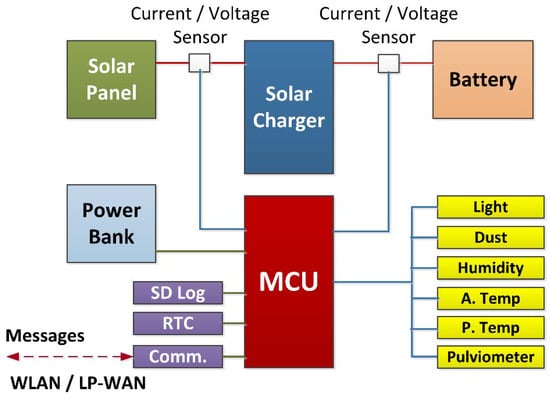
Figure 1.
The architecture of a fully equipped wireless sensor node for solar data acquisition.
In the model, all sensors are connected to the same microcontroller unit (MCU), as shown in Figure 1. The MCU can be Arduino UNO or Arduino MEGA. In addition to sensors, the MCU can be connected to Real Time Clock (RTC), communication module, and SD card module for data logging and a liquid–crystal display (LCD) or organic light-emitting diode (OLED) module optionally. The communication module depends on the coverage of the presented network, which will be discussed in more detail in the following part of this section.
The possible set of sensors that can be considered for the proposed sensor node is the DHT-11 or DHT-22 sensor for air temperature and humidity, TMP36 for a solar panel temperature, BH1750 sensor and other light sensors for light intensity measuring; UV sensor; ACS712 or INA169 current sensor; MAX471 current and voltage sensor; etc. The solar charger is Seeedstudio Li-Po Rider Pro. It is used for managing Li-Po battery 500 mAh charging and discharging. The solar panel dimensions range from 160 mm × 138 mm × 2.5 mm to 130 mm × 87 mm × 2.5 mm, but other sizes will be taken into consideration also. The panel’s efficiency is 16%, voltage 5.5V, 3W power, and peak current depends and ranges from 540 mA to 270 mA. The communication module for Wi-Fi technology can be ESP8266 or ESP32. It is interesting to consider the usage of Wemos D1 R2 or NodeMCU boards with integrated ESP8266/ESP32 modules instead of using Arduino UNO boards. The limiting factor in using Wemos or NodeMCU boards can be the possibility of connecting only one analog sensor.
The proposed fully equipped sensor node should be considered part of the distributed wireless sensor network for solar panel data acquisition, as presented in Figure 2. The sensor network has nine elements. It is based on the smart factory sensor network prototype shown in [36].
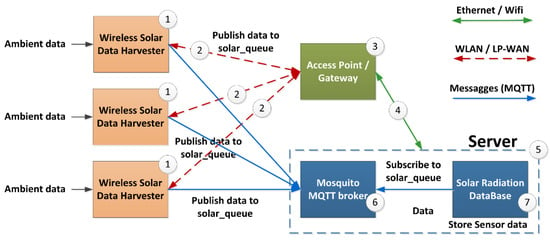
Figure 2.
Elements of distributed wireless sensor network for solar radiation data acquisition.
Wireless sensor nodes are the first element of the distributed sensor network (1). The wireless sensor network coverage defines the technology used for communication (2). The Wi-Fi technology and one of its variants (IEEE 802.11b/h/n/ac/ax/ad) should be considered if the network is designed for short or middle-range coverage. For long-range coverage (a few kilometers), the LoRa/LoRaWAN should be considered [37,38,39]. For further research, the investigation of using the IEEE 802.11ah should be very interesting.
The same is with the device connecting the wireless nodes (3). When using one of the Wi-Fi technology variants, the access point should be used as a concentration device. When using LoRa/LoRaWAN technology, the LoRaWAN gateway should be used. The connection (4) between the server (5) and concentrating device (3) can be realized with Wi-Fi or wired technology but should be based on IP protocol. The server’s primary role (5) is collecting, storing, processing, and analyzing collected data. Collected and analyzed data will be available to the system users through web interfaces with live graphs, dashboards, and reports. The collector for the data sent from the wireless nodes is the open-source server (6) based on messaging protocol, probably MQTT (MQ Telemetry Transport) [40]. Finally, data collection should be realized with the DB storage system (7), SQL, or NoSQL, depending on the number of nodes and required data acquisition and writing frequency.
The last two elements of the system depend on the communication technology used for connecting nodes (1) and concentrating device (3) and concentrating device and server (5). Suppose the connection from the node is based on Wi-Fi technology, and the further connection to the server is based on Wi-Fi or Ethernet (wired) technologies. In that case, the messages containing collected data will be sent with the MQTT messaging protocol. When LoRa/LoRaWAN protocol is used for node connectivity, the conversion from LoRa to MQTT messages will be implemented at the LoRaWAN gateway–concentrating device (3).
In this research, the authors did not test the proposed system on a full scale during the continuous operation of Arduino and clone devices. As the following sections explain, the node prototype is built as a small and laboratory-scale setup for testing purposes, as planned in the project’s current phase. The future phase will cover building the sensor node network and its full data acquisition operation.
Estimating the efficiency of the proposed device, the authors rely on previous personal experiences such as in [36,37,38,39] and numerous external research sources where the Arduino UNO and its clones are proven reliable devices. The effects of high-temperature exposure of sensor nodes will be examined in the project’s future phases, relying on previous experiences. Possible measures for reducing heat and dust exposure will be used in designing protective cases for sensor nodes in further research.
The lack of experimentation with the continuous operation of Arduino boards in the open environment under direct exposure to sunlight and temperature is the major problem of this research in the current phase. However, this will be explored in many details in the future, primarily with the design of protective cases and node temperature monitoring with thermal cameras or temperature sensors.
4. Experiment
This section presents an experimental platform to examine the efficiency of using open-source, low-cost, and prototyping components to develop a solar panel data acquisition network. The platform’s photo is shown in Figure 3. The platform is built upon the prototyped node from the previous chapter (Figure 1).
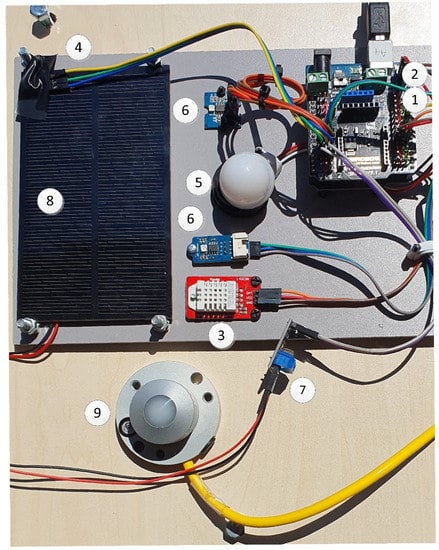
Figure 3.
Prototype platform based on Arduino for experimenting with solar panel data acquisition.
The architecture of the testing platform is developed as a reduced model presented in Figure 1, shown in Figure 3. The platform is designed to measure the accuracy of a low-cost voltage sensor for solar panel performance monitoring. After justifying its accuracy, the relation of other measurement values with the panel voltage output is analyzed. The voltage sensor was chosen for this experiment as the single sensor that can simultaneously measure and analyze solar radiation and solar panel efficiency.
The testing platform (Figure 3) is based on low-cost open-source hardware (OSHW) components. Open-source hardware allows rapid assembly, development, and configuration of sensor devices. The value of a sensor device built with open-source components is given in Table 3, which is below 50 EUR. Instead of Node MCU, Wemos D1 or Arduino and its clones with integrated or connected Wi-Fi modules can also be considered. If some components are changed, the price will be close to the presented one. The level of prices can depend on a region or the current offer of the market, but it can be similar.

Table 3.
The price of the components of the sensor node.
The central part of the platform is a PC (Personal Computer) with the Windows operating system. PC logs the data collected with a sensor node and digital multimeter. A Digital multimeter is used to make control measurements and validate the voltage sensor’s accuracy. The MCU used in the testing platform is Arduino UNO (1). Arduino UNO is connected to the sensor shield (2). Arduino sends data to the PC via Universal Serial Bus (USB). It is programmed to read the data from the voltage sensor and send data to the PC via USB. PC reads the data sent to the COM port and logs it in comma-separated values (CSV) file using putty terminal software.
The control measurement is made with a digital multimeter (DMM) connected to a PC via USB. The data are sent to a PC, where the open-source digital multimeter reader program UltraDMM is used to visualize and log the data. Both devices are connected in parallel with the solar panel. The other components of the platform are (Figure 3): (3) DHT-22 sensor for air temperature and humidity, (4) TMP36 sensor for solar panel temperature, (5) light BH1750 sensor for light intensity, (6) UV sensors, (7) voltage sensor, (8) solar panel: 130 mm × 87 mm × 2.5 mm (efficiency 16%, 5.5V, 3W, peak current 270 mA), and (9) pyranometer. The pyranometer is not integral to this open-source platform and is only used for control measurements.
The testing phase should be before the project’s continuation and the sensor network’s development and deployment to prove its ability and efficiency and justify its usage. To measure the solar panel performance under different conditions in the shortest period possible, the experiment uses natural sunlight in combination with artificial light sources in indoor space. Three light bulbs are used: incandescent, compact fluorescent light (CFL), and LED. Additionally, the indoor ambient light is used (Figure 4). As described before, the response of the solar panel, the voltage change, is measured in parallel with the Arduino platform voltage sensor and digital multimeter.
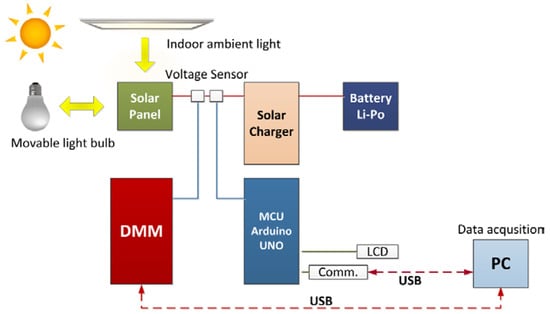
Figure 4.
Prototype platform based on Arduino for testing the performance of voltage sensors.
The methodology of usage of the platform in the research is depicted in Figure 5, where the algorithm of the research methodology is presented. The algorithm shows seven steps. The steps are as follows: (1) design of the platform with the definition of the components and building of the platform, (2) data acquisition of the solar radiation-related data and logging to the PC, (3) parsing of collected values and (4) data processing performed at PC with the usage of Python and/or GNU Octave, (5) creation of reports and comparison of data processing outputs, (6) evaluation of the accuracy of estimation and deciding if the evaluation results are acceptable, and in the case, if they are not acceptable triggering re-design of the platform, and in the case if results are acceptable, forwarding to (7) implementation of the estimation techniques to the firmware of sensor nodes. The algorithm of the research flow is presented in Figure 5.
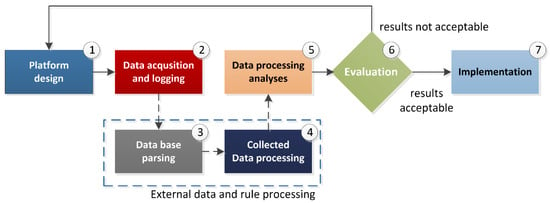
Figure 5.
Algorithm of research flow.
5. Results
In this section are described the results of the experiments. The results are acquired with the experiment conducted in two phases. The experiment’s first phase evaluates the voltage sensor’s accuracy. The first phase is divided into two subphases. The second experiment is driven to find the relation between voltage and other measured values, such as panel temperature, air temperature and humidity, UV, and sunlight intensity.
5.1. Results of the Voltage Sensor Measurements
The first subphase of the first experiment is conducted with sunlight only. First, the testing platform is exposed to direct sunlight. The transparent plexiglass is placed over the testing platform in the next subphase. The amount of sunlight is reduced by gradually covering the plexiglass with colored semi-transparent foils, as shown in Figure 6. This step-by-step covering is performed because the authors wanted to test the voltage sensor response with different sunlight intensities, avoiding testing in mid or long-term periods. By adding semi-transparent foils, the authors simulated the reduction of sunlight and different sunlight intensities. At the final stage of the testing process, the solar panel is covered with a non-transparent cover.
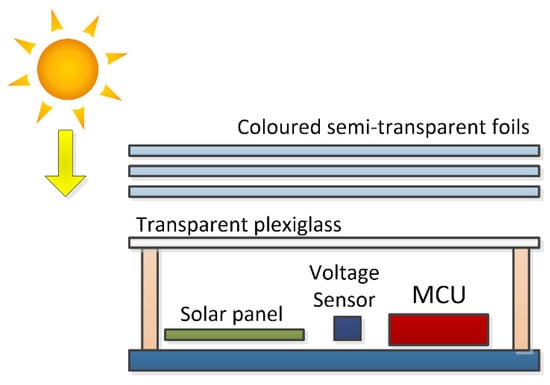
Figure 6.
Solar panel voltage measurement with semi-transparent folios.
The effects achieved in this phase can be seen in Figure 7, with the graduate decreasing solar panel voltage. The figure shows the comparison of sensor and digital multimeter results. The voltage sensor offers good capabilities because both measurements were similar, with a slight difference. The lowest values in Figure 7 are for the test cases when a non-transparent cover is used. Even in this case, there is a distance between the solar panel and the cover, and the solar panel generated voltage.
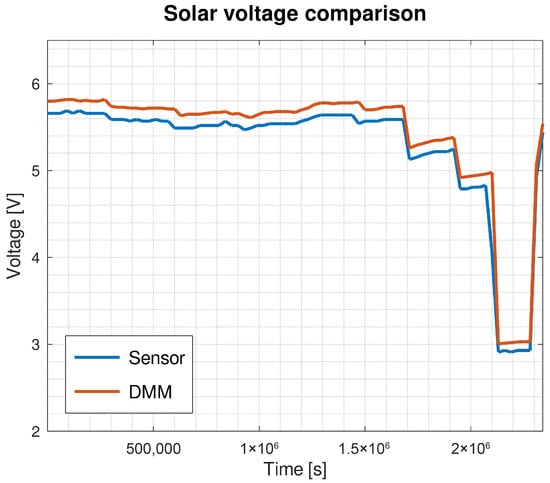
Figure 7.
Comparison of the voltage sensor and digital multimeter measurement using sunlight.
Next, the test continued with indoor ambient light and artificial light sources. This testing phase aimed to monitor the voltage sensor response when exposed to different light sources. The testing platform is exposed to indoor ambient light and an additional three light bulb sources to achieve that goal. Three bulbs are used: incandescent, compact fluorescent light (CFL), and light-emitting diode (LED). The bulbs are mounted to the bulb holder with an adjustable bulb height. The bulb height gradually changed as it was measured at six different distances (35, 30, 25, 20, 15, and 10 cm) from the solar panel. The seventh test phase is with the bulb turned off. The platform with the adjustable bulb holder is presented in Figure 8.
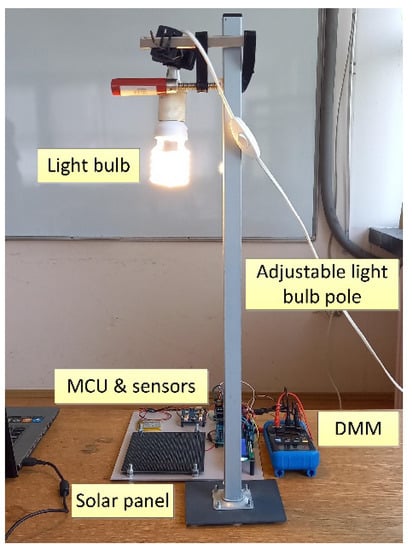
Figure 8.
The platform with the adjustable bulb holder.
The joint results of the sensor and digital multimeter for all three bulbs are presented in Figure 9. Again, the results of both sensors are similar.
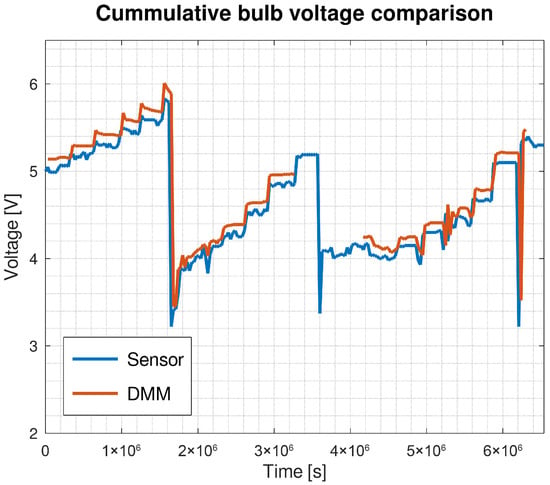
Figure 9.
Comparison of the voltage sensor and digital multimeter cumulative measurements for three types of bulbs.
Figure 9 shows that three light sources have different values gradually. The first part of the graph is with the results of incandescent light. When the light bulb is positioned at 35 cm, the values are around 5 V, with 30 cm height values around 5.2 V, and up to 6 V when the bulb is 10 cm from the solar panel. When the bulb is off, the measured values are around 3.2 V.
The next part of the graph shows results with the exact distances for CFL and LED bulbs, respectively.
Further, the comparative results of measurements for three bulbs separately are shown. Figure 10, Figure 11 and Figure 12 show the comparative results for incandescent, CFL, and LED bulbs, respectively.
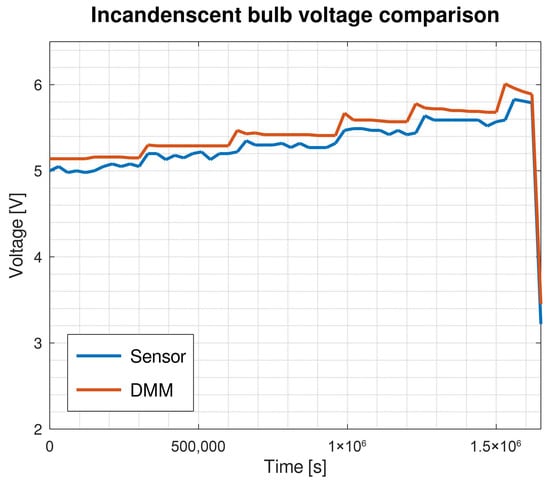
Figure 10.
Comparison of the voltage sensor and digital multimeter measurement using an incandescent bulb.
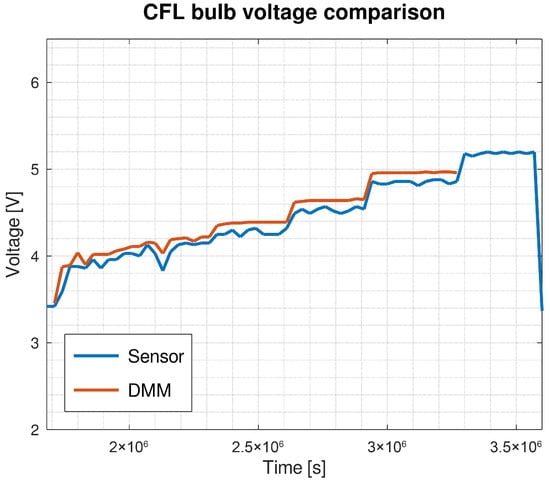
Figure 11.
Comparison of the voltage sensor and digital multimeter measurement using CFL bulb.
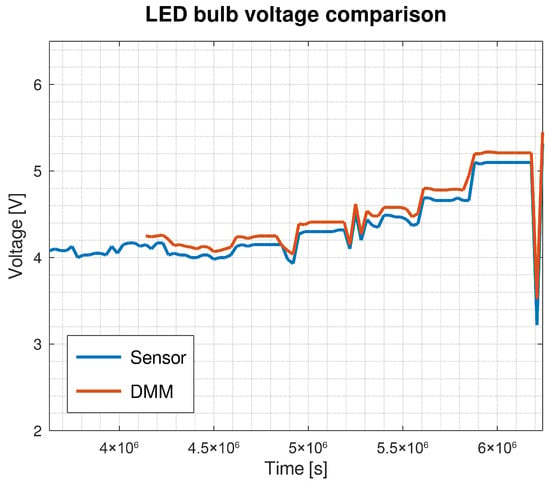
Figure 12.
Comparison of the voltage sensor and digital multimeter measurement using LED bulb.
Figure 10 compares DMM and voltage sensor measurements with the incandescent bulb used to simulate the light source. Similar measurement values are visualized. The visualization of the measurements clearly shows the voltage sensor’s accuracy, confirming its justification for usage in the measurements platform.
Figure 11 and Figure 12 similarly compare DMM and voltage sensor measurements with the CFL and LED bulbs that simulate the light source. As in the previous case, the similarity of the measured results is obvious. The visualization again confirms the accuracy of the voltage sensor without dependence on the light source. With these results, the justification of the measurement platform is additionally confirmed.
The summarization of the results for all four light sources is given in Table 4. The table shows the measured values in volts between the sensor and the digital multimeter. The difference is presented with the Root Mean Square Error (RMSE).

Table 4.
The comparison of measurement results with solar light and with incandescent, CFL, and LED bulbs.
The test proved the accuracy of the voltage sensor, justifying its usage in the proposed architecture. The difference in sensor and DMM measured values ranges from 0.11 to 0.17 V. In addition to its accuracy, the platform shows satisfying behavior during the test period. The platform was stable and easy to set up and handle.
The measurement results and the platform performance experiment can be considered successful.
5.2. The Relation of the Other Sensor Values to the Voltage Sensor Measurements
The experimental platform for the second phase was configured to measure the UV and sunlight intensity values, the solar panel temperature value, and the air temperature and humidity values. The specification and description of the sensors and their R2 (coefficient of determination) to output voltage are given in Table 5. The coefficient of determination R2 will be used for estimation formula accuracy. Python is used for fitting the data and calculating the R2. The data in the table show that the UV sensor has the greatest influence on the solar panel output voltage. The second best R2 is with the visible light sensor. The reason why the UV sensor has a greater relation compared to the visible light sensor might be that the UV sensor uses 10-bit values in the range of 0–1023 to measure UV light intensity, while the BH1750 sensor is optimized for measuring light in lux units with 16-bit values ranging from 0–65535.

Table 5.
The configuration of the experimental platform and sensor specification.
Because the UV light and BH1750FVI sensors have the highest R2 values, further fitting is made with solar panel output voltage. The fitting is made with Python using exponential fitting, logarithmic, and power functions. The fitting results of the UV sensor are shown in Table 6 and Table 7 for the BH1750 sensor, respectively.

Table 6.
The fitting results for the UV sensor.

Table 7.
The fitting results for the BH1750 sensor.
Again, the UV sensor has better fitting results than the BH1750 sensor. For both sensors, the exponential fitting function gives the best results. Three fitting functions that can be used for estimating panel output voltage based on UV sensor measurements are calculated by Python script as follows:
Exponential function
Logarithmic function
Power function
The estimated values of output voltage calculated on the measured values of the UV sensor are given for all three functions and compared to measured voltage results and visualized (Figure 13). As in Table 6, the fitting with the exponential function provides the best results. Two other functions (logarithmic and power) give similar results, with much lower accuracy than the exponential function.
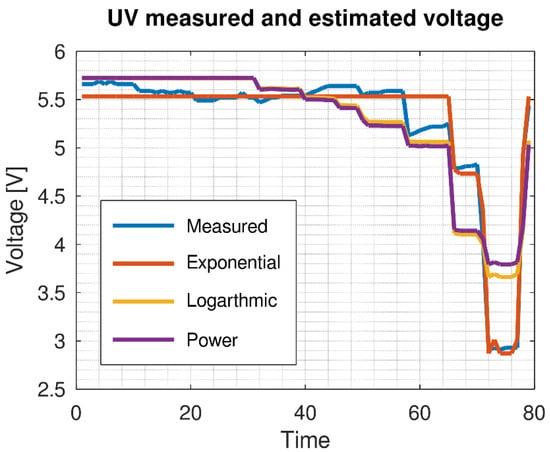
Figure 13.
Comparison of the voltage sensor measurements and estimated values with three functions.
All three functions’ fitting curves are compared to the measured output voltage values and visualized in Figure 14. Again, as shown in Table 7, the fitting with exponential functions gives the best results. Again, two other functions (logarithmic and power) provide similar results, with much lower accuracy than the exponential function. The similarity of measured values with those estimated with the exponential function is visible in Figure 13 and Figure 14, and the values almost overlap.
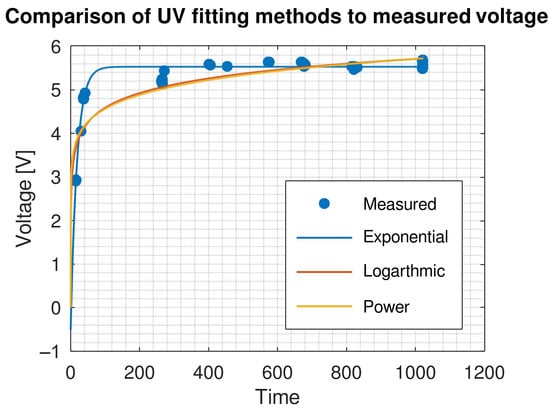
Figure 14.
Comparison of the voltage sensor measurements and fitting curves for all three functions.
5.3. The Summary of the Paper’s Contribution
The benefits of the proposed and existing work are multiple. This paper contributes to the distributed wireless sensor network system architecture based on open-source hardware and open-source software technologies. The proposed architecture is designed for acquiring solar radiation data and other ambient parameters. The data are collected to define nonlinear regression estimation techniques for predicting solar panel voltage outputs and, in addition, to analyze and monitor the influence of multiple ambient data on the efficiency of solar panels. The proposed architecture is implemented at a partial scale. It is not implemented as a fully developed wireless sensor network with many sensor nodes deployed in the city area or some part of the city for long-term exploration. The proposed architecture is implemented with a prototype sensor node designed to be part of the network, as planned in this research phase. The same sensor node is evaluated for collecting solar panel voltage generation data with open-source hardware and low-cost components. The sensor node is evaluated in different scenarios with solar and artificial light conditions for the feasibility of the proposed architecture and justification of its usage. The collected data are used for creating of nonlinear regression model for voltage output estimation.
The benefits of the paper’s contribution are as follows. This approach opens a way of introducing estimation techniques for sensor nodes in sensor networks. This can be useful in implementing estimation techniques in edge devices in solar data acquisition networks. Thus, we can use the sensor networks designed for usage other than solar radiation data acquisition, such as air pollution monitoring, and weather and meteorological data networks to use their sensors to predict solar radiation data. This will allow using non-specially designed wireless sensor networks for solar data estimation and solar radiation mapping, planning optimal deployment of solar-powered sensor nodes, and solar-powered sensor node efficient energy management.
Additionally, the model of estimating the solar panel performance and capacity based on the presented approach can be used to manage the energy-efficient solar-powered sensor nodes. The model for their management is an ongoing phase of the project, but it is out of the focus of this paper.
The results of this research apply to any industrial Wireless Sensor Network and the Internet of Things with solar-powered sensor nodes. This means that any outdoor deployed sensor network can use the results of this research. Those networks can be utilized in various scenarios, such as environmental monitoring, smart agriculture, the construction industry, and the smart grid [41].
Additionally, the same platform and methodology can be used in developing solar radiation estimation techniques using AI in edge computing, as seen in numerous examples [42,43,44]. This implementation of AI is planned as future work, and it will be based on the Python programming language and Scikit-learn [45] and Keras [46] packages.
The limitation of the study is, as mentioned before, its short evaluation period. Because of the project plan and current progress, the critical issue was to avoid long-term testing. Therefore, the prototype is tested with natural solar and artificial light in various scenarios.
6. Conclusions
The vital issue of designing efficient solar-powered sensor networks is addressed in this paper. A proposal for the solution to the problem is given with the architecture of the solar radiation data acquisition sensor nodes and network. The architecture of the sensor network and sensor nodes are presented and described with their main features. The proposed system collects solar radiation data and builds a model to estimate solar panel outputs accurately. The proposed platform collects data to analyze solar radiation and the influence of ambient data on solar panel performance. The collected data were used to create nonlinear regression models to estimate solar panel behavior. The created nonlinear regression models could be implemented on edge devices in complex sensor networks.
This paper proposes solar energy research and a teaching platform by combining the two approaches in solar panel research. One approach is solar radiation estimation based on various techniques using terrain, rooftop configuration, LIDAR, and other data. The different approach is the usage of Arduino-based open-source hardware components for building platforms for monitoring various solar-powered systems. The research proposes a low-cost, accurate platform for estimating solar radiation by combining these two approaches. The key paper’s contributions are a platform for data acquisition and a method for implementing estimation techniques for sensor nodes in various sensor and IoT networks, which helps achieve edge intelligence not limited to solar data acquisition networks. This system can significantly improve the process of developing systems with efficient solar powering of the sensor nodes. It can offer optimal operation settings of sensor nodes in various Industrial IoT. The small-scale prototype of the system was implemented, relying on the authors’ previous experience in designing a smart factory system using open-source hardware.
The experimental results show that the system can be effectively used as a tool for data collection valid for estimating the output of sensor node-based solar panels. Thus, it can be used to determine the most suitable locations for positioning sensor nodes in various outdoor locations for Industrial IoT and other WSN, IoT, and smart city applications. Additionally, by estimating solar panel outputs, the model of the sensor node operations can be changed dynamically. Thus, during its operation, the sensor node can change its power-saving modes from full operation to modem-sleep, light-sleep, or deep-sleep modes.
The summarization of our work is as follows. This paper contributes to the proposed sensor network model for solar panel data acquisition with the models of its essential elements, such as fully-equipped and reduced-equipped sensor nodes. The model is evaluated to assess the efficiency and feasibility of using low-cost open-source hardware components to acquire solar panel data and estimate solar panel outputs. To avoid long-term tests, the experiment is performed under the simulated environment with direct solar light, reduced solar light, indoor ambient light, and different artificial light sources at different distances from the solar panel.
The evaluated sensor nodes can be used in future research for solar radiation mapping of micro-locations in urban scenarios. The solution can be used further in engineering education for building a lab for teaching IT students the development of solar-powered sensor nodes and for laboratory experiments with the solar-powered sensor node design. These features will be further explored in the future phases of this project. The other further steps in this research will be to build and validate the full-scale sensor network. The third effort in further research can be made with the collection of ambient and solar radiation data and the usage of collected data for further data analysis of ambient parameters’ impact on solar panel efficiency. Together with data collection, new estimation models using different machine-learning techniques will be built. These new models will be evaluated for implementing artificial intelligence and machine learning in edge devices and, therefore, edge computing. This research direction can be extensive with the possible implementation of various AI techniques, using Python programming language and packages such as Scikit-learn and Keras and their adaptation to the Arduino platform.
Author Contributions
Conceptualization, D.D. and J.P.; methodology, D.D.; software, D.D.; validation, D.D., J.P., E.D. and L.R.; formal analysis, M.M. and S.M.; investigation, M.M. and S.M.; resources, D.D. and J.P.; data curation, D.D., J.P. and L.D.; writing—original draft preparation, D.D., M.M. and S.M.; writing—review and editing, E.D. and L.R.; visualization, D.D.; supervision, L.R. and I.P.; project administration, E.D.; funding acquisition, E.D. All authors have read and agreed to the published version of the manuscript.
Funding
The research is conducted through the project “Creating laboratory conditions for research, development, and education in the field of the use of solar resources in the Internet of Things” at the Technical Faculty “Mihajlo Pupin” Zrenjanin, financed by the Provincial Secretariat for Higher Education and Scientific Research, Republic of Serbia, Autonomous Province of Vojvodina, Project number 142-451-3118/2022-01.
Institutional Review Board Statement
Not applicable.
Informed Consent Statement
Not applicable.
Data Availability Statement
Not applicable.
Acknowledgments
This research is supported by the Provincial Secretariat for Higher Education and Scientific Research, Republic of Serbia, Autonomous Province of Vojvodina, Project number 142-451-3118/2022-01. with the project “Creating laboratory conditions for research, development, and education in the field of the use of solar resources in the Internet of Things”.
Conflicts of Interest
The authors declare no conflict of interest.
Abbreviations
| ADAS | Automatic Data Acquisition Systems |
| AI | Artificial Intelligence |
| ANN | Artificial Neural Networks |
| BP | Back Propagation |
| CFL | Compact Fluorescent Light |
| CNN | Convolutional Neural Network |
| COM | Communication port |
| CSV | Comma-Separated Values |
| DB | Database |
| DMM | Digital Multi Meter |
| GIS | Geographic Information System |
| GPU | Graphic Processing Unit |
| I2C | Inter-Integrated Circuit; pronounced as “eye-squared-C”), also I2C or IIC |
| IEEE | Institute of Electrical and Electronics Engineers |
| IIoT | Industrial Internet of Things |
| IP | Internet Protocol |
| LCD | Liquid Crystal Display |
| LED | Light-Emitting Diode |
| LIDAR | LIght Detection And Ranging |
| MCU | Micro Controller Unit |
| ML | Machine Learning |
| MQTT | MQ Telemetry Transport |
| NoSQL | non-SQL/non-relational |
| OLED | Organic Light Emitting Diode |
| OSHW | Open-Source Hardware |
| PC | Personal Computer |
| PV | Photovoltaic |
| RF | Random Forest |
| RMSE | Root-mean-square error |
| RNN | Recurrent Neural Network |
| RTC | Real-Time Clock |
| SD | Secure Digital |
| SQL | Structured Query Language |
| SVM | Support Vector Machine |
| SPI | Serial Peripheral Interface |
| TCP | Transmission Control Protocol |
| UART | Universal Asynchronous Receiver-Transmitter |
| USB | Universal Serial Bus |
| UV | Ultraviolet |
| Wi-Fi | Wireless Fidelity |
| WSN | Wireless Sensor Networks |
Notations
| Vexp | Voltage calculated with an exponential function. |
| Vlog | Voltage calculated with a logarithmic function. |
| Vpow | Voltage estimated with a power function. |
| UV | Analog value 0–1023 of the UV sensor read |
| R2 | or r2 (R-square), the coefficient of determination |
References
- Djordjevic, L.; Pekez, J.; Novakovic, B.; Bakator, M.; Djurdjev, M.; Cockalo, D.; Jovanovic, S. Increasing Energy Efficiency of Buildings in Serbia—A Case of an Urban Neighborhood. Sustainability 2023, 15, 6300. [Google Scholar] [CrossRef]
- Ašonja, A.; Vuković, V. The Potentials of Solar Energy in the Republic of Serbia: Current Situation, Possibilities and Barriers. App. Eng. Lett. 2018, 3, 90–97. [Google Scholar] [CrossRef]
- Varga, P.; Peto, J.; Franko, A.; Balla, D.; Haja, D.; Janky, F.; Soos, G.; Ficzere, D.; Maliosz, M.; Toka, L. 5G support for Industrial IoT Applications—Challenges, Solutions, and Research gaps. Sensors 2020, 20, 828. Available online: https://www.mdpi.com/1424-8220/20/3/828 (accessed on 14 March 2023). [CrossRef] [PubMed]
- Aljarboa, A.A.; Al-Mubaid, H. Smart Technology Systems for Sustainable Cities: A Review of the Literature. Sustain. Cities Soc. 2021, 74, 103188. [Google Scholar]
- Adekoya, A.A.; Mohd Zin, A.A.; Abdul-Malek, Z. Integration of solar energy in industrial internet of things (IIoT) for sustainable smart technology systems. Energies 2021, 14, 820. [Google Scholar]
- El Hammoumi, A.; Motahhir, S.; Chalh, A.; El Ghzizal, A.; Derouich, A. Low-cost virtual instrumentation of PV panel characteristics using Excel and Arduino in comparison with traditional instrumentation. Renew. Wind. Water Sol. 2018, 5, 3. [Google Scholar] [CrossRef]
- Mnati, M.J.; Van den Bossche, A.; Chisab, R.F. A Smart Voltage and Current Monitoring System for Three Phase Inverters Using an Android Smartphone Application. Sensors 2017, 4, 872. [Google Scholar] [CrossRef]
- De la Cruz Severiche, M.Z.; Fernández, V.; Díaz, R. Low-Cost HEM with Arduino and Zigbee Technologies in the Energy Sector in Colombia. Energies 2022, 15, 3819. [Google Scholar] [CrossRef]
- Pachauri, R.K.; Mahela, O.P.; Khan, B.; Kumar, A.; Agarwal, S.; Alhelou, H.H.; Bai, J. Development of arduino assisted data acquisition system for solar photovoltaic array characterization under partial shading conditions. Comput. Electr. Eng. 2021, 92, 107175. [Google Scholar] [CrossRef]
- Ruiz, S.G.; Calderita, L.V.; Hidalgo-Paniagua, A.; Rubio, J.P.B. Measuring Smoothness as a Factor for Efficient and Socially Accepted Robot Motion. Sensors 2020, 23, 6822. [Google Scholar] [CrossRef]
- Lambert, J.; Monahan, R.; Casey, K. Power Consumption Profiling of a Lightweight Development Board: Sensing with the INA219 and Teensy 4.0 Microcontroller. Electronics 2020, 10, 775. [Google Scholar] [CrossRef]
- Jabbar, W.A.; Annathurai, S.; Rahim, T.A.A.; Fauzi, M.F.M. Smart energy meter based on a long-range wide-area network for a stand-alone photovoltaic system. Expert Syst. Appl. 2022, 197, 116703. [Google Scholar] [CrossRef]
- Melo, G.C.G.D.; Torres, I.C.; Araújo, Í.B.Q.d.; Brito, D.B.; Barboza, E.d.A. A Low-Cost IoT System for Real-Time Monitoring of Climatic Variables and Photovoltaic Generation for Smart Grid Application. Sensors 2021, 21, 3293. [Google Scholar] [CrossRef] [PubMed]
- Vargas-Salgado, C.; Aguila-Leon, J.; Chiñas-Palacios, C.; Hurtado-Perez, E. Low-cost web-based Supervisory Control and Data Acquisition system for a microgrid testbed: A case study in design and implementation for academic and research applications. Heliyon 2019, 5, e02474. [Google Scholar] [CrossRef] [PubMed]
- Viciana, E.; Alcayde, A.; Montoya, F.G.; Baños, R.; Arrabal-Campos, F.M.; Zapata-Sierra, A.; Manzano-Agugliaro, F. Open Zmeter: An Efficient Low-Cost Energy Smart Meter and Power Quality Analyzer. Sustainability 2018, 10, 4038. [Google Scholar] [CrossRef]
- Portalo, J.M.; González, I.; Calderón, A.J. Monitoring System for Tracking a PV Generator in an Experimental Smart Microgrid: An Open-Source Solution. Sustainability 2021, 13, 8182. [Google Scholar] [CrossRef]
- Gimeno-Sales, F.J.; Orts-Grau, S.; Escribá-Aparisi, A.; González-Altozano, P.; Balbastre-Peralta, I.; Martínez-Márquez, C.I.; Gasque, M.; Seguí-Chilet, S. PV Monitoring System for a Water Pumping Scheme with a Lithium-Ion Battery Using Free Open-Source Software and IoT Technologies. Sustainability 2020, 12, 10651. [Google Scholar] [CrossRef]
- Paredes-Parra, J.M.; Mateo-Aroca, A.; Silvente-Niñirola, G.; Bueso, M.C.; Molina-García, Á. PV Module Monitoring System Based on Low-Cost Solutions: Wireless Raspberry Application and Assessment. Energies 2018, 11, 3051. [Google Scholar] [CrossRef]
- Pereira, R.I.S.; Dupont, I.M.; Carvalho, P.C.M.; Jucá, S.C.S. IoT embedded Linux system based on Raspberry Pi applied to real-time cloud monitoring of a decentralized photovoltaic plant. Measurement 2018, 114, 286–297. [Google Scholar] [CrossRef]
- Pereira, R.I.S.; Jucá, S.C.S.; Carvalho, P.C.M. IoT embedded systems network and sensors signal conditioning applied to decentralized photovoltaic plants. Measurement 2019, 142, 195–212. [Google Scholar] [CrossRef]
- García, E.; Ponluisa, N.; Quiles, E.; Zotovic-Stanisic, R.; Gutiérrez, S.C. Solar Panels String Predictive and Parametric Fault Diagnosis Using Low-Cost Sensors. Sensors 2022, 22, 332. [Google Scholar] [CrossRef] [PubMed]
- Mallahi, F.A.; Mohamed, M.; Shaker, Y.O. Integration of Solar Energy Supply on Smart Distribution Board Based on IoT System. Designs 2022, 6, 118. [Google Scholar] [CrossRef]
- Panagopoulos, O.; Argiriou, A.A. Low-Cost Data Acquisition System for Solar Thermal Collectors. Electronics 2022, 11, 934. [Google Scholar] [CrossRef]
- Ninsawat, S.; Hossain, M.D. Identifying Potential Area and Financial Prospects of Rooftop Solar Photovoltaics (PV). Sustainability 2016, 8, 1068. [Google Scholar] [CrossRef]
- Sakti, A.D.; Ihsan, K.T.N.; Anggraini, T.S.; Shabrina, Z.; Sasongko, N.A.; Fachrizal, R.; Aziz, M.; Aryal, J.; Yuliarto, B.; Hadi, P.O.; et al. Multi-Criteria Assessment for City-Wide Rooftop Solar PV Deployment: A Case Study of Bandung, Indonesia. Remote Sens. 2022, 14, 2796. [Google Scholar] [CrossRef]
- Huang, Y.; Chen, Z.; Wu, B.; Chen, L.; Mao, W.; Zhao, F.; Wu, J.; Wu, J.; Yu, B. Estimating Roof Solar Energy Potential in the Downtown Area Using a GPU-Accelerated Solar Radiation Model and Airborne LiDAR Data. Remote Sens. 2015, 7, 17212–17233. [Google Scholar] [CrossRef]
- Zhu, R.; Wong, M.S.; You, L.; Santi, P.; Nichol, J.; Ho, H.C.; Lu, L.; Ratti, C. The effect of urban morphology on the solar capacity of three-dimensional cities. Renew. Energy 2020, 153, 1111–1126. [Google Scholar] [CrossRef]
- Huang, Z.; Mendis, T.; Xu, S. Urban solar utilization potential mapping via deep learning technology: A case study of Wuhan, China. Appl. Energy 2019, 250, 283–291. [Google Scholar] [CrossRef]
- Brito, M.C.; Redweik, P.; Catita, C.; Freitas, S.; Santos, M. 3D Solar Potential in the Urban Environment: A Case Study in Lisbon. Energies 2019, 12, 3457. [Google Scholar] [CrossRef]
- Kosovic, I.N.; Mastelic, T.; Ivankovic, D. Using Artificial Intelligence on environmental data from Internet of Things for estimating solar radiation: Comprehensive analysis. J. Clean. Prod. 2020, 266, 121489. [Google Scholar] [CrossRef]
- Alassery, F.; Alzahrani, A.; Khan, A.I.; Irshad, K.; Islam, S. An artificial intelligence-based solar radiation prophesy model for green energy utilization in energy management system. Sustain. Energy Technol. Assess. 2022, 52, 102060. [Google Scholar] [CrossRef]
- Du, B.; Lund, P.D.; Wang, J. Improving the accuracy of predicting the performance of solar collectors through clustering analysis with artificial neural network models. Energy Rep. 2022, 8, 3970–3981. [Google Scholar] [CrossRef]
- Pang, Z.; Niu, F.; O’Neill, Z. Solar radiation prediction using recurrent neural network and artificial neural network: A case study with comparisons. Renew. Energy 2020, 156, 279–289. [Google Scholar] [CrossRef]
- Wu, J.; Qin, W.; Wang, L.; Hu, B.; Song, Y.; Zhang, M. Mapping clear-sky surface solar ultraviolet radiation in China at 1 km spatial resolution using Machine Learning technique and Google Earth Engine. Atmospheric Environ. 2022, 286, 119219. [Google Scholar] [CrossRef]
- Núñez-Reyes, A.; Ruiz-Moreno, S. Spatial Estimation of Solar Radiation Using Geostatistics and Machine Learning Techniques. IFAC-Papers 2020, 53, 3216–3222. [Google Scholar] [CrossRef]
- Dobrilovic, D.; Brtka, V.; Stojanov, Z.; Jotanovic, G.; Perakovic, D.; Jausevac, G.A. Model for Working Environment Monitoring in Smart Manufacturing. Appl. Sci. 2021, 11, 2850. [Google Scholar] [CrossRef]
- Dobrilovic, D.; Malic, M.; Malic, D.; Sladojevic, S.; Dalibor, D.; Milan, M.; Dušan, M.; Srđan, S. Analyses and optimization of Lee propagation model for LoRa 868 MHz network deployments in urban areas. J. Eng. Manag. Compet. 2017, 7, 55–62. [Google Scholar] [CrossRef]
- Dobrilović, D.; Brtka, V.; Jotanović, G.; Stojanov, Ž.; Jauševac, G.; Malić, M. The urban traffic noise monitoring system based on LoRaWAN technology. Wirel. Networks 2022, 28, 441–458. [Google Scholar] [CrossRef]
- Flammini, F.; Gaglione, A.; Tokody, D.; Dobrilovic, D. LoRa WAN Roaming for Intelligent Shipment Tracking. In Proceedings of the 2020 IEEE Global Conference on Artificial Intelligence and Internet of Things (GCAIoT), Dubai, United Arab Emirates, 12–16 December 2020; pp. 1–2. [Google Scholar] [CrossRef]
- Dobrilović, D.; Petrović, D.; Malić, M. Usability of open-source hardware based platform for indoor positioning systems. J. Eng. Manag. Compet. 2018, 8, 113–120. [Google Scholar] [CrossRef]
- Malik, P.K.; Sharma, R.; Singh, R.; Gehlot, A.; Satapathy, S.C.; Alnumay, W.S.; Pelusi, D.; Ghosh, U.; Nayak, J. Industrial Internet of Things and its Applications in Industry 4.0: State of The Art. Comput. Commun. 2021, 166, 125–139. [Google Scholar] [CrossRef]
- Iftikhar, S.; Gill, S.S.; Song, C.; Xu, M.; Aslanpour, M.S.; Toosi, A.N.; Du, J.; Wu, H.; Ghosh, S.; Chowdhury, D.; et al. AI-based fog and edge computing: A systematic review, taxonomy and future directions. Internet Things 2023, 21, 100674. [Google Scholar] [CrossRef]
- Firouzi, F.; Farahani, B.; Marinšek, A. The convergence and interplay of edge, fog, and cloud in the AI-driven Internet of Things (IoT). Inf. Syst. 2022, 107, 101840. [Google Scholar] [CrossRef]
- Gill, S.S.; Xu, M.; Ottaviani, C.; Patros, P.; Bahsoon, R.; Shaghaghi, A.; Golec, M.; Stankovski, V.; Wu, H.; Abraham, A.; et al. AI for next generation computing: Emerging trends and future directions. Internet Things 2022, 19, 100514. [Google Scholar] [CrossRef]
- Pedregosa, F.; Varoquaux, G.; Gramfort, A.; Michel, V.; Thirion, B.; Grisel, O.; Blondel, M.; Prettenhofer, P.; Weiss, R.; Dubourg, V.; et al. Scikit-learn: Machine Learning in Python. J. Mach. Learn. Res. 2011, 12, 2825–2830. [Google Scholar]
- Chollet, F. Keras. 2015. Available online: https://keras.io (accessed on 21 April 2023).
Disclaimer/Publisher’s Note: The statements, opinions and data contained in all publications are solely those of the individual author(s) and contributor(s) and not of MDPI and/or the editor(s). MDPI and/or the editor(s) disclaim responsibility for any injury to people or property resulting from any ideas, methods, instructions or products referred to in the content. |
© 2023 by the authors. Licensee MDPI, Basel, Switzerland. This article is an open access article distributed under the terms and conditions of the Creative Commons Attribution (CC BY) license (https://creativecommons.org/licenses/by/4.0/).